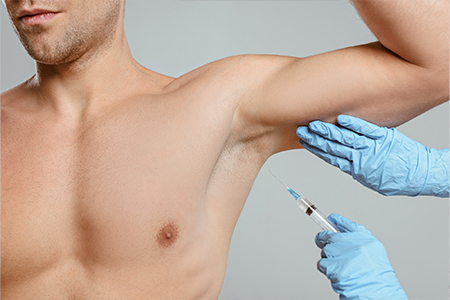Sweat Treatments
Underarms:
 In the realm of medical treatments, Botox has garnered significant attention for its effectiveness in addressing underarm sweating, a condition known as hyperhidrosis. Numerous studies have yielded varying results, yet a wealth of evidence underscores Botox's capacity to reduce armpit sweat production by over 50% for a duration extending up to six months.
In the realm of medical treatments, Botox has garnered significant attention for its effectiveness in addressing underarm sweating, a condition known as hyperhidrosis. Numerous studies have yielded varying results, yet a wealth of evidence underscores Botox's capacity to reduce armpit sweat production by over 50% for a duration extending up to six months.
It's worth noting that while Botox is officially sanctioned for underarm sweating, physicians often employ it "off-label" to alleviate sweating in other areas of the body, such as the palms, face, and soles of the feet.
Palms:
Regarding palm sweating, ongoing research endeavors have explored Botox's potential efficacy in this domain. Studies indicate that Botox treatments may lead to a reduction in sweating ranging from 25% to 50% over a period spanning from three weeks to six months.
Face/Scalp:
Similarly, investigations into the use of Botox for facial sweating have yielded encouraging findings. Although research in this area remains somewhat limited, preliminary studies suggest that Botox injections could effectively mitigate facial sweating for a duration of five to six months. It's essential to note that the most commonly reported side effect involves temporary paralysis of facial muscles, particularly in the forehead region.
Soles of Feet:
Furthermore, Botox shows promise in addressing excessive sweating on the soles of the feet, although research in this realm is comparatively scarce. A small-scale study conducted in 2018 revealed that 73% of participants aged 12 to 17 expressed satisfaction with the outcomes of Botox treatment for plantar hyperhidrosis.
In summary, while Botox's official approval pertains solely to underarm sweating, emerging evidence suggests its potential efficacy in mitigating sweating in other areas of the body. As with any medical intervention, individuals considering Botox treatment should consult with a qualified healthcare professional to assess its suitability and discuss potential risks and benefits.



